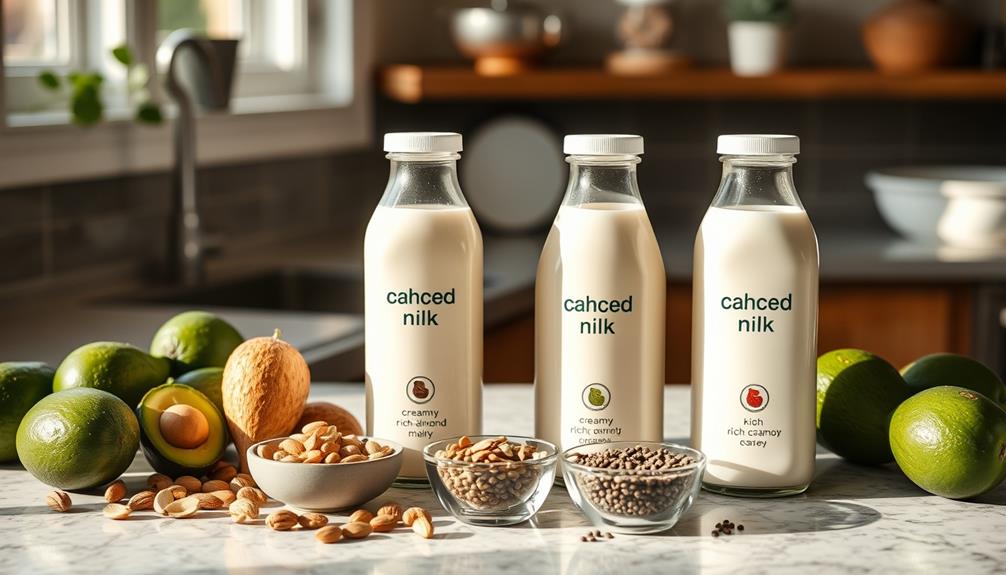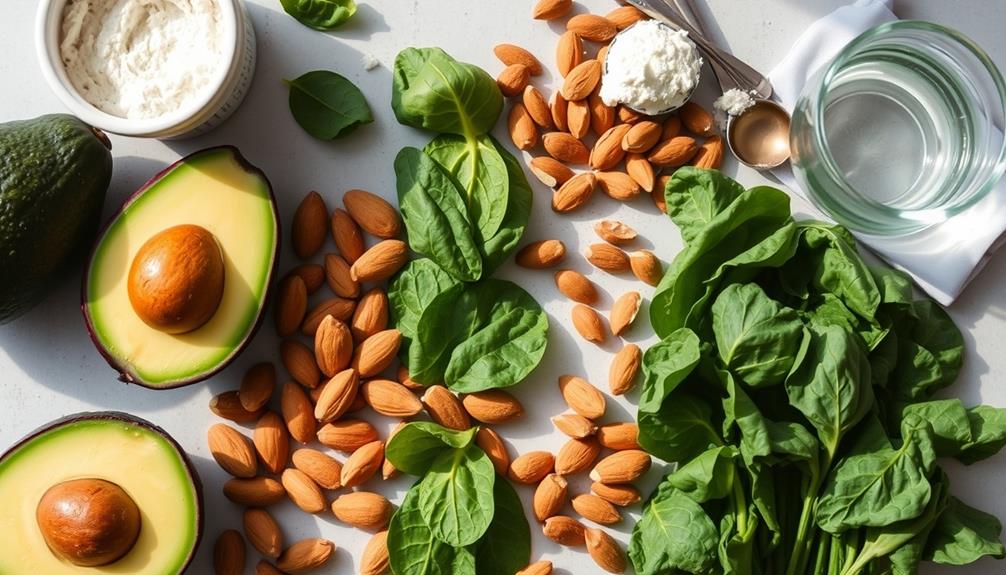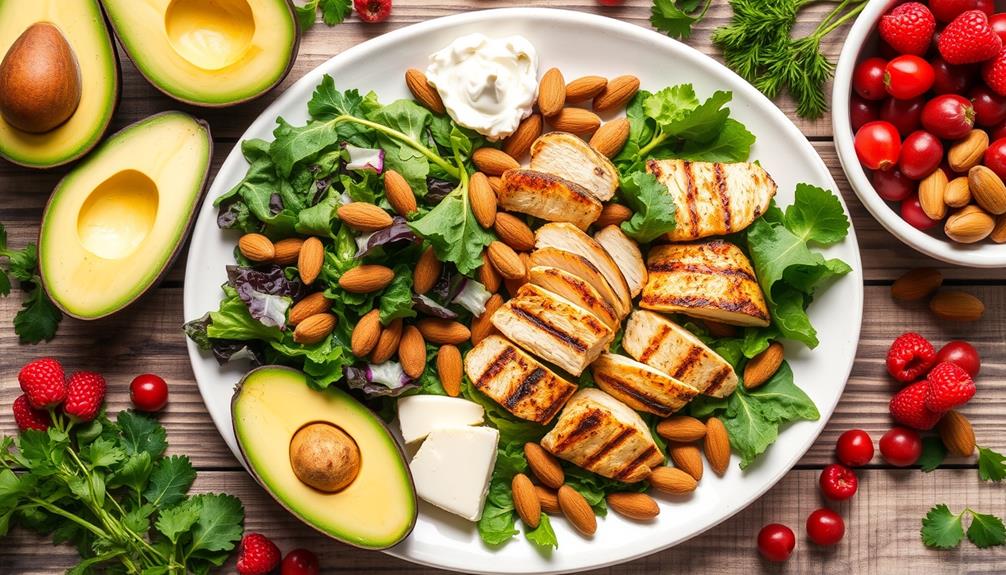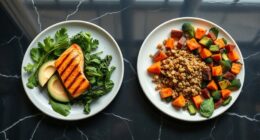When you're on a keto diet, finding the right non-dairy milk is essential. Unsweetened almond milk is a top choice, with just 1 gram of net carbs per cup. Macadamia nut milk is even lower, boasting less than 1 gram of net carbs. Coconut milk can be versatile too, but watch out for its higher carb content. If you prefer plant-based options, flaxseed and hemp milks are excellent for their healthy fats and low carb counts. Always opt for unsweetened varieties to keep your intake low. There's plenty more to explore about these options and how they fit into your diet.
Key Takeaways
- Unsweetened almond milk is a top choice, with only 1 gram of net carbs and rich in vitamin E.
- Macadamia nut milk is ideal for keto, offering less than 1 gram of net carbs and high monounsaturated fats.
- Coconut milk provides healthy fats but can have up to 5 grams of net carbs per cup; choose unsweetened varieties.
- Flaxseed milk is beneficial for omega-3 fatty acids and has only 1 gram of net carbs per cup.
- Always opt for unsweetened versions and check ingredient lists to avoid added sugars and fillers.
Overview of Keto Milk Alternatives
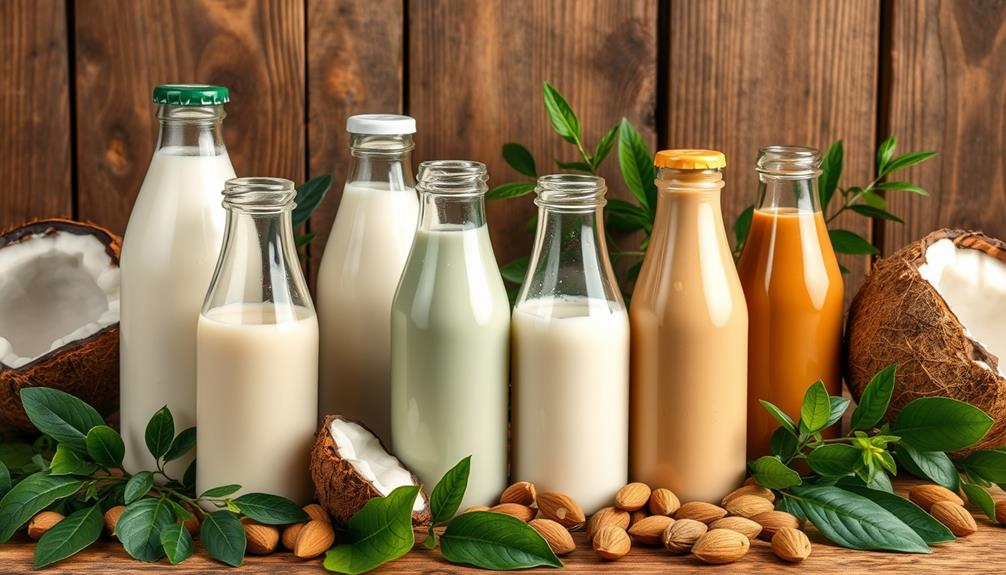
When you're on a keto diet, finding suitable milk alternatives can make a big difference in your meal planning. Luckily, there are several keto-friendly options that cater to your low-carb needs.
Almond milk is one of the most popular choices, boasting about 1 gram of net carbs per cup, especially when you choose unsweetened varieties. Additionally, many almond milk brands are fortified with vitamins and minerals, enhancing their nutritional profile, which can be beneficial for overall health and wellness, similar to the benefits of antioxidants in juices.
Coconut milk can also fit into your keto lifestyle, with some brands offering up to 5 grams of net carbs per cup, making it versatile for various dishes.
For those seeking a creamier texture, macadamia nut milk is a fantastic alternative, containing less than 1 gram of net carbs per cup.
Flaxseed milk is another nutritious option, providing 1 gram of net carbs per cup and a rich supply of omega-3 fatty acids.
Finally, consider pea milk, which offers around 2 grams of net carbs per cup and a protein boost with 8 grams per serving, making it an excellent dairy-free option.
Top Nut-Based Milk Choices

When it comes to nut-based milk, almond milk stands out with its low net carb count, making it a fantastic option for your keto diet.
Additionally, the use of essential oils, such as eucalyptus oil, known for its decongestant effects, can enhance your overall wellness while following a keto lifestyle.
You'll also love the creamy texture of cashew milk, perfect for enhancing your favorite recipes.
Plus, macadamia nut milk offers a rich flavor and healthy fats, rounding out your choices beautifully.
Almond Milk Benefits
Almond milk stands out as a top choice for those following a keto diet, thanks to its low carbohydrate content and impressive nutritional profile. Additionally, the rising popularity of non-dairy milk options has led to innovations in flavor and texture, making them increasingly appealing for various diets, including keto.
Here are some key benefits of almond milk:
- Low in Net Carbs: With approximately 1 gram of net carbs per cup, it's perfect for low-carb diets.
- Rich in Vitamin E: Unsweetened almond milk provides antioxidant benefits that support skin health and overall wellness.
- Low-Calorie Option: At just about 30 calories per 8 oz serving, it can help maintain calorie deficits for weight loss on the keto diet.
- Versatile Flavor: Its light, nutty flavor enhances smoothies, coffee, baking, and savory dishes while adhering to keto guidelines.
Various brewing methods lead to unique coffee experiences that can pair well with almond milk.
Choosing almond milk over dairy milk can be a game-changer for your diet. Whether you're looking to cut down on calories or seeking a keto-friendly alternative, almond milk delivers.
Plus, it's easy to make at home by blending soaked almonds with water, allowing you to customize it without added sugars or preservatives.
Enjoy the benefits of almond milk and elevate your keto lifestyle!
Creamy Cashew Milk
If you're looking for a creamy, delicious alternative to dairy while sticking to your keto diet, creamy cashew milk is an excellent choice. With only about 1-2 grams of net carbs per cup, it fits perfectly into your low-carb lifestyle.
The rich, creamy texture of cashew milk enhances smoothies, soups, and baked goods, allowing you to enjoy your favorite recipes without the excess carbohydrates. Additionally, incorporating natural remedies can complement your diet and overall health.
You can easily make homemade cashew milk by blending soaked cashews with water, making sure you use unsweetened varieties to maintain keto compliance. This way, you control the ingredients and make certain it's free from added sugars.
However, if you're opting for commercial options, be sure to check the labels—some brands include sweeteners that can increase the carb content considerably.
In addition to being low in carbs, creamy cashew milk is a good source of healthy fats, making it a perfect substitute for higher-carb dairy products.
Whether you're pouring it over your morning coffee or using it in your favorite keto recipes, cashew milk adds a delightful creaminess that you'll love.
Macadamia Nut Milk
For those seeking a low-carb, creamy alternative to dairy, macadamia nut milk stands out as a top choice in the nut-based milk category.
It's worth noting that many cooking and baking recipes can be adapted to include this nut milk, similar to how butter adds flavor and moisture to baked goods.
Here's why you should consider incorporating it into your keto diet:
- Low Net Carbs: With less than 1 gram of net carbs per cup, it's one of the lowest carb nut milk options available.
- High in Fat: Approximately 3.5 grams of total fat per serving aligns perfectly with the high-fat requirements of the keto diet.
- Unsweetened Varieties: Available in unsweetened versions, macadamia nut milk is free from added sugars, helping you maintain ketosis.
- Heart-Healthy Fats: Rich in monounsaturated fats, it supports heart health and can improve cholesterol levels.
This versatile dairy-free option can be used in smoothies, coffee, and even baking, making it a fantastic addition to your recipes.
Its rich, creamy texture mimics cow's milk, enhancing your meals without derailing your diet.
Seed-Based Milk Options

When it comes to keto-friendly non-dairy milk, seed-based options like flaxseed, hemp, and pea milk stand out for their low carb content and nutritional benefits. Incorporating yoga for back pain into your routine can also complement your overall wellness while following a keto diet.
Flaxseed milk, for instance, contains only 1 gram of net carbs per cup and is packed with omega-3 fatty acids, making it a nutritious choice for your keto diet. Hemp milk typically has 1-2 grams of net carbs per serving, providing a creamy texture perfect for smoothies or coffee while also delivering essential omega-3 and omega-6 fatty acids.
Pea milk, derived from yellow peas, is another excellent option, boasting 8 grams of protein and just 2 grams of net carbs per 8 oz serving. This makes it a fantastic choice, especially if you have nut or soy allergies.
Seed-based milks like flax and hemp are low in carbs and contribute additional nutrients such as protein and fiber, supporting your overall health.
Plus, with homemade options available, you can easily blend flaxseeds or hemp seeds with water, ensuring no added sugars compromise your keto compliance. Enjoy these delicious and nutritious alternatives to enhance your diet!
Dairy-Based Alternatives for Keto

When you're on a keto diet, heavy cream is a fantastic option, offering less than 1 gram of carbs per tablespoon and a rich taste.
Additionally, understanding the importance of budgeting for groceries can help you make informed choices while following a keto lifestyle.
Half-and-half can also be useful, adding creaminess to your drinks with just 1-2 grams of carbs per tablespoon.
It's important to check for added sugars in these dairy alternatives to keep your carb intake in check while enjoying their benefits.
Heavy Cream Benefits
Heavy cream stands out as one of the best dairy-based alternatives for those following a keto diet. Here are some benefits you'll love:
- Low Carb: With only about 1 gram of carbs per tablespoon, heavy cream keeps you on track with your keto goals. Additionally, its high-fat content provides a satisfying alternative to traditional dairy, much like how energy-saving features in heat pumps enhance overall efficiency.
- High Fat: Containing around 36% to 40% fat, it's perfect for boosting your fat intake.
- Creaminess: Heavy cream adds a luscious richness to soups, sauces, and desserts, enhancing flavors without the extra carbs.
- Versatile Substitute: Use it in coffee or tea as a rich substitute for traditional milk, allowing you to enjoy creamy beverages without spiking your carb count.
Unlike regular milk, which packs about 12 grams of carbs per cup, heavy cream helps maintain ketosis while providing that satisfying, indulgent flavor.
If you're craving a milk-like texture, simply dilute heavy cream with water to achieve a similar consistency, all while keeping your carb counts low. This way, you can savor the creaminess of heavy cream without compromising your keto lifestyle!
Half-and-Half Uses
Half-and-half serves as a fantastic option for those on a keto diet, offering a creamy texture without overwhelming your carb count. With only 1-2 grams of net carbs per tablespoon, it fits perfectly into your low-carb lifestyle. This blend of milk and heavy cream enhances your favorite recipes, adding flavor and richness while maintaining the fat content you need for keto.
Additionally, for those who are exploring the dietary needs of small pets, it's important to understand how to keep them healthy while enjoying various food options, such as proper diet essentials.
You can use half-and-half in coffee, sauces, and soups, giving you versatility without greatly increasing your carb intake. If you want to create a milk-like consistency for cooking or baking, consider diluting half-and-half with water. This way, you can enjoy a creamy texture without compromising your diet.
When selecting half-and-half, always opt for the unsweetened varieties. This is vital to avoid added sugars that can disrupt your ketosis. By integrating half-and-half into your meal plans, you can enjoy rich flavors and creamy textures while sticking to your keto diet.
Whether you're whipping up a decadent sauce or enriching your morning coffee, half-and-half is a delightful and practical choice for your low-carb lifestyle.
Nutritional Value Comparison
Often overlooked, the nutritional value of dairy-based alternatives is essential for anyone on a keto diet. Understanding the carbohydrate content and overall nutritional facts can help you make the best choices.
Here's a quick comparison of some popular dairy-based options that can also promote educational play through creativity:
- Heavy Cream: Less than 1 gram of net carbs per tablespoon; high in fat.
- Half-and-Half: Contains 1-2 grams of carbs per tablespoon; moderate choice for creaminess.
- Unsweetened Coconut Milk: Typically has 1-5 grams of net carbs per cup; offers healthy fats.
- Whey Protein Powder: Provides 1-2 grams of carbs per serving; great for muscle recovery.
When considering the best milk for keto, keep in mind that almond milk contains about 1-2 grams of net carbs per cup, making it another low-carb option.
Full-fat yogurt can fit into your diet in moderation, but opt for unsweetened varieties to keep carb intake low.
These dairy-based keto milk options can be beneficial on your journey, offering high-fat content while remaining low in carbohydrates, especially when compared to many plant-based milk options.
Nutritional Benefits of Milk Alternatives
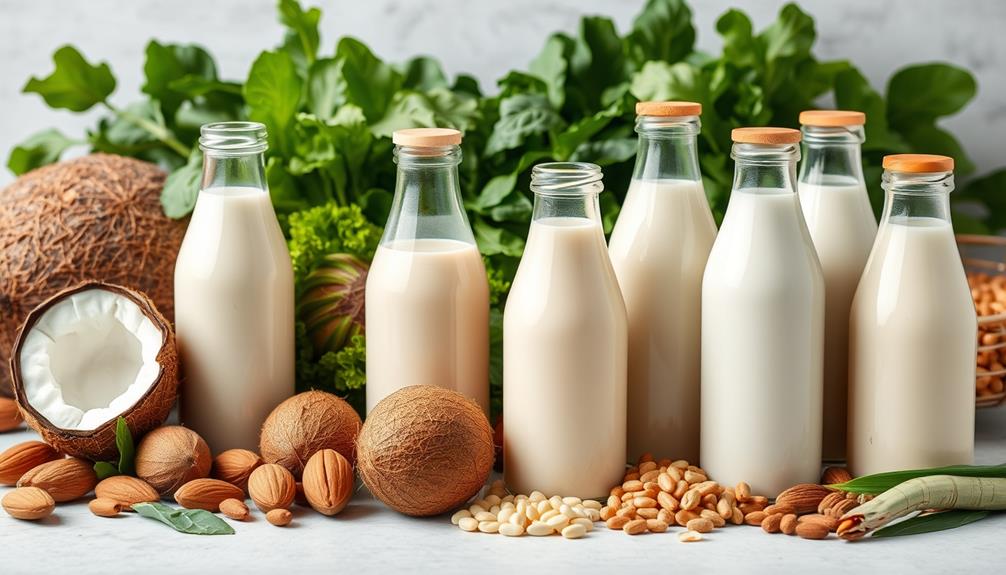
Many people are turning to milk alternatives for their nutritional benefits, especially those following a keto diet. These non-dairy milk substitutes provide a variety of advantages that align perfectly with your dietary goals.
For instance, unsweetened almond milk is low in calories and carbs, containing only about 30 calories and under 1 gram of net carbs per 8 oz serving, while also being rich in vitamin E, which supports skin health.
If you're looking for heart-healthy options, flaxseed milk is an excellent choice. It's packed with omega-3 fatty acids, offering 1 gram of carbs per cup, along with protein and fiber for digestive support.
Hemp milk also contributes to your wellness by providing both omega-3 and omega-6 fatty acids, with just 1-2 grams of net carbs per serving.
For a creamier option, macadamia nut milk is high in monounsaturated fats, boasting around 0 grams of net carbs.
Coconut milk, on the other hand, is versatile with healthy fats and can contain up to 5 grams of net carbs per cup, enhancing both savory dishes and desserts.
These milk alternatives offer fantastic nutritional benefits to keep your keto diet on track.
Tips for Choosing the Right Milk

When picking the right non-dairy milk for your keto diet, it's crucial to sift through the options carefully. Here are some tips to guide your choice: First, be sure to choose non-dairy milks that are unsweetened and free of added sugars. This will help keep your carbohydrate intake low, which is essential for staying in ketosis. Additionally, look for non-dairy milks that are high in healthy fats, such as almond milk, coconut milk, or macadamia nut milk. These options are some of the best ketofriendly milk options because they provide a good source of fat and minimal carbohydrates. By carefully considering these factors, you can find the perfect non-dairy milk to support your keto lifestyle.
- Choose Unsweetened Varieties: Opt for unsweetened non-dairy milk to keep net carbs low. Sweetened options can easily exceed 5 grams of carbs per serving.
- Check Carbohydrate Content: Look at the nutritional labels and aim for options with under 5 grams of net carbs per cup. Almond milk has just 1g net carbs, while macadamia nut milk boasts 0g.
- Prioritize Higher Fat Content: Select options with higher fat content. Heavy cream has only 1g carbs per tablespoon, and coconut milk can have up to 5g carbs per cup, both aligning well with keto goals.
- Examine the Ingredient List: Be cautious of additives and fillers that can sneak in extra carbs. A simple, clear ingredient list is your best bet.
Also, consider fortified options like flaxseed milk, which enhance your diet with additional nutrients such as omega-3 fatty acids.
Frequently Asked Questions
What Non Dairy Milk Is Keto?
When choosing non-dairy milk for keto, consider options like unsweetened almond, macadamia nut, or flaxseed milk. They're low in net carbs and can fit seamlessly into your low-carb lifestyle while providing essential nutrients.
Is Almond Milk Allowed on Keto Diet?
Almond milk's like a gentle breeze on a warm day; it's light and invigorating. Yes, you can enjoy almond milk on a keto diet, just make sure it's unsweetened to keep your carb count low.
Is Oat Milk Keto-Friendly?
Oat milk isn't keto-friendly due to its high carbohydrate content, which can disrupt your ketosis. Instead, you should choose lower-carb alternatives like unsweetened almond or coconut milk to stay within your daily carb limits.
How Do I Replace Dairy in My Keto Diet?
You might be wondering how to replace dairy in your keto diet. Start by exploring options like unsweetened almond milk or heavy cream; they're low in carbs and perfect for your delicious, keto-friendly meals.
Conclusion
To sum up, finding the best non-dairy milk for your keto diet doesn't have to be a challenge. With nut-based, seed-based, and even some dairy alternatives at your disposal, you can easily enjoy your favorite beverages without compromising your goals. So, why settle for something that doesn't fit your lifestyle? Embrace the variety of options available, and you'll not only enhance your meals but also nourish your body while staying true to your keto journey! If you’re looking for the best almond milk options for keto, you’ll be pleased to know that there are plenty of unsweetened almond milk brands that are low in carbohydrates and high in healthy fats. Some popular choices include Almond Breeze Unsweetened Original Almond Milk and Silk Unsweetened Almond Milk. Additionally, you can experiment with making your own almond milk at home to ensure it is completely free of added sugars and other unwanted ingredients. With these options, you can easily find the best almond milk for your keto diet.
